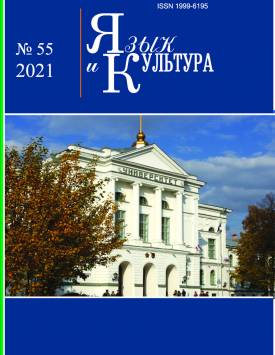Intonation usage standard of canonical imperatives: expressing emotions
Intonation usage standard in discourse as object of experimental research raises a question about changes in traditional paradigm of linguistic research. Systemic use of cognitive-discursive approach to experimental research suggests the necessity of taking the data obtained by other sciences connected with the human cognition as foundation. Knowing how psychic mechanisms of attention and memory function in speech comprehension and production the researcher can identify the direction cognitive processes take in discourse, the normalizing function of probability as significant characteristic of this activity. Interdisciplinarity helps to establish new means of formalization and quantification of linguistic units in discourse, create a unified description of intonation usage standards in different types of discourse. Methodology of experimental discourse analysis helps to resolve difficulties motivated by specific character of intonation as the objective of research: its high variability, its dependence on the discourse function of the utterance provide for the multifactorality of discourse research and the difficulty of controlling the variables in it. Giving an accurate definition to the concept of naturalness/spontaneity of speech, observing a rigid experiment design, using corpus analysis to investigate the contextual environment of speech allows to show and prove the causal relationship between the prosodic components of the intonation pattern of the utterance, to formalize additional factors that influence the usage of language units in speech (attractors and fuzzifiers). Having defined the discourse as a complex structure of knowledge that can be represented in a text with characteristics that reflect the application of that knowledge in practical activity, the cognitive-discursive approach gives logical and consistent foundation to use the dramatic (fiction) texts in the research devoted to intonation usage standard. Corpus analysis gives vast information on discursive conditions of utterance production and helps to identify factors that can influence the intonational organization of the utterance performed by the reader. Activation of the readers' psychic mechanisms of attention and memory by the elements of the text used by the authors is possible if there is “common knowledge” of rules and standards that control the effectiveness of the discourse shared by all its participants. To ensure the control over variables in the experimental research of intonation usage standard canonical imperatives were used in experimental research. They are characterized by unique syntactic structure and perlocutionary force. Corpus analysis, acoustic analysis and statistical evaluation of its results, comparative analysis of prosodic data obtained in the research allow to make the following conclusions about intonation usage standards of canonical imperatives in discourse: 1. The peculiarity of intonation usage in canonical imperatives becomes apparent at the stage of context environment analysis: most frequent verbs of speech causality do not denote the illocutionary force of the utterance, but rather mark its perlocu-tionary function. Verbs of speech causality denote characteristics of the immediate speech production process and mark the emotional state of the speaker as “neutral/emotional”. At the same time, they do not necessarily name the emotion. Intonation structures accompanied by verbs of speech causality that mark utterances as “emotional” are characterized by the higher level of intensity/loudness and greater variability of intensity parameter in the utterance. The distribution of the intensity both in the utterances marked as “neutral” and “emotional” is similar. 2. F0 parameter is considered dominating in the intonational structure of an utterance. Its behavior in the intonation contours of the utterance in the samples does not show direct and unambiguous correlation to the emotional meanings of utterances as is described in the codified intonation standard of the English language. Intonation usage norm of canonical imperative utterances contains intonation constructions of two types: in the 1st type construction the tonal movement is performed on the duration of several adjacent syllables, in the 2nd type constructions the tonal movement id performed within one syllable. Falling tune is predominant in intonation contours of all types. Rising tune is more characteristic for the intonation constructions of the 1st type. Complex tunes among which Fall Rise и Fall Rise Fall are most frequent appear in the intonation constructions of the 2nd type.
Keywords
intonation usage standard, discourse, experiment design, canonical imperative, verb of speech causality, intonation contour, intensity, emotional weight index, attractor, fuzzifierAuthors
| Name | Organization | |
| Zhigalev B.A. | Linguistics University of Nizhniy Novgorod | zhigalev@lunn.ru |
| Nenasheva Iu.A. | South Ural State Humanitarian Pedagogical University | nenashevayua@cspu.ru |
| Zhigaleva K.B. | State University of Nizhny Novgorod | kbzhigaleva@gmail.com |
| Serikov V. V. | Institute of Education Development Strategy of the Russian Academy of Education | vladislav.cerikoff@yandex.ru |
References

Intonation usage standard of canonical imperatives: expressing emotions | Yazyk i Kultura – Language and Culture. 2021. № 55. DOI: 10.17223/19996195/55/4
